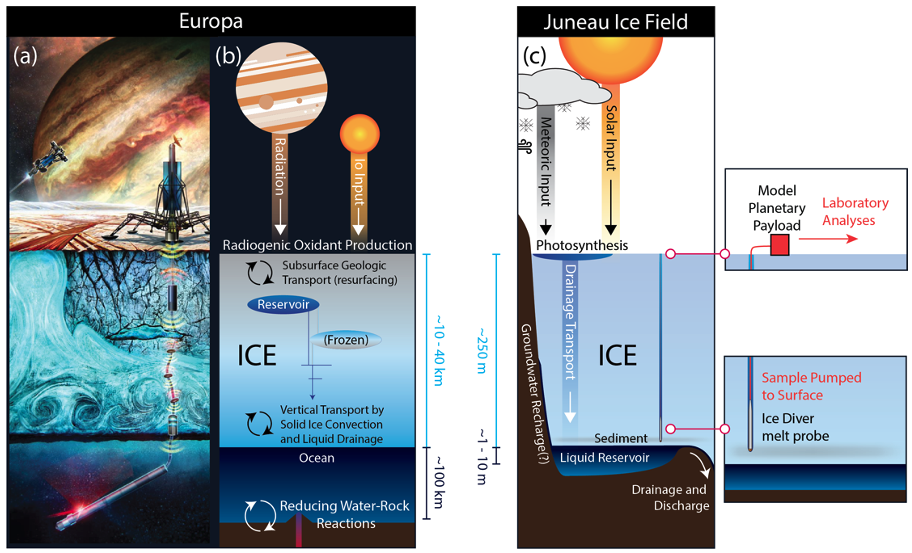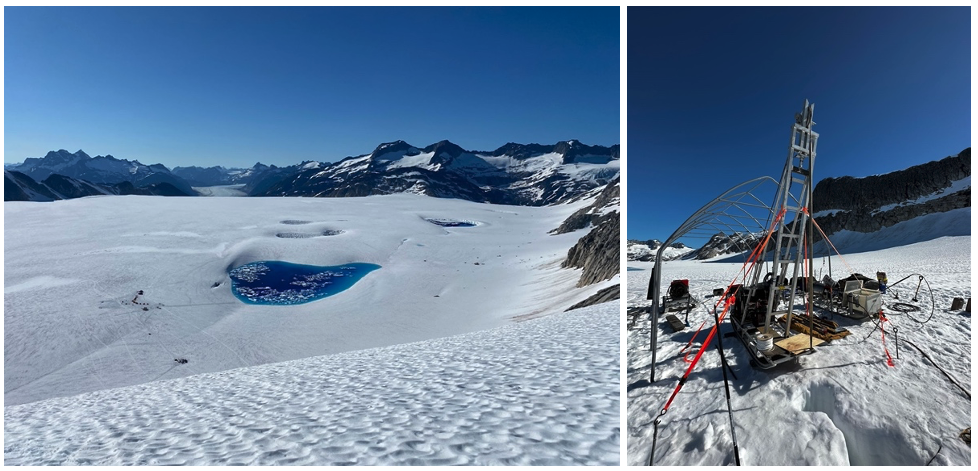Onward to Planetary Ocean Access: The ORCAA Cryobot Analogue Mission to the Juneau Icefield
- 1Jet Propulsion Laboratory, California Institute of Technology
- 2University of Maine
- 4University of Tennessee, Knoxville
- 5University of Washington, Applied Physics Laboratory
- 6Montana State University
- 7California Institute of Technology
Introduction. The future exploration of Europa and other Ocean Worlds may involve the direct in situ access and characterization of ice crusts and subsurface liquid water using autonomous melt probes, called Cryobots. The Ocean Worlds Reconnaissance and Characterization of Astrobiological Analogs (ORCAA) project is a multi-institution effort, funded under NASA’s Planetary Science and Technology Through Analog Research (PSTAR) program. ORCAA aims to advance our understanding of cryosphere environments on Earth, enabled by planetary subsurface exploration technologies, while envisioning science operations for future icy subsurface access missions.
Objectives. Our overall objectives include the demonstration of subglacial lake access by a terrestrial Cryobot through two field work campaigns. We aim at sampling and analysis borehole melt and subglacial water to understand the evolution of icy habitable environments and the life they host. Through this work, we also aim to elucidate the importance of the hydrological connectivity that may permit nutrient migration and the establishment of habitable or inhabited niches in planetary ice shells. Uniting these science and technology demonstration objectives, we will demonstrate a science concept of operations by additionally simulating command cycles for a subsurface access science mission at Europa with a remote planetary Science Team. While no terrestrial glacier is a perfect physical, chemical, or biological analog to Europa, the Juneau Icefield offers diverse glaciated systems in which to study glacier microbiomes, hydrology and concept operations around melt probe deployment and icy sample handling (Fig. 1).

Figure 1: Comparison between Europa and the Juneau Icefield, AK, where the analogue Cryobot mission is conducted.
Methods. The ORCAA project comprises two field campaigns, in summers 2023 and 2025, on the Juneau Icefield. During the July 2023 field campaign, we successfully tested separately each aspect of the project. The camp was set up nearby supraglacial lakes (Fig. 2), which play an important part in glacier microbiomes. Geophysical reconnaissance was conducted using radar, and used to measure the glacier bedrock depth at the drilling site. We also conducted a full assessment of the 2025 drilling site, identifying the structure and depth of the subglacial lake we will access. The drilling was conducted using a hot water drill (Fig. 2), which will be replaced by a terrestrial Cryobot from the University of Washington, in 2025. Water sampling and analysis was conducted in several supraglacial lakes around camp, as well as in the borehole. Mission control and decision making was conducted in real time in 2023. Finally, we handled and documented logistics associated with field work in icy environments.

Figure 2: Right: Supraglacial lakes and science camp on the Juneau Icefield, AK. Left: Hot water drill used to reach the glacier bedrock.
Building upon this acquired knowledge, we will conduct a comprehensive Europa-analogue subglacial water access and characterization mission with the follow up 2025 field campaign. The terrestrial Cryobot and autonomous spooling and deployment system will handle melting and descent through the ice, as well as water sampling and pumping to the surface. Samples will be analyzed in a clean environment by a team of micro– and astrobiologists. We will simulate complete command cycles and cryobot autonomy to determine how and when scientists and autonomous systems discover indicators of change in the physical environment, habitability, and biological communities, and to characterize the temporal and spatial fidelity requirements of observations.
Acknowledgements. Portions of this research were carried out at the Jet Propulsion Laboratory, California Institute of Technology, under contract with the National Aeronautics and Space Administration (NASA). This work is supported by NASA’s Astrobiology program through Planetary Science and Technology from Analog Research (PSTAR) program (80NM0018F0613).
How to cite: Lesage, E., M. Howell, S., Campbell, S., Mikucki, J., Winebrenner, D., A. Cwik, T., Perl, S., Smith, M., Burnett, J., Clance, J., Clavette, R., Garner, M., Haq, S., Javier, B., and Holmes, J. D.: Onward to Planetary Ocean Access: The ORCAA Cryobot Analogue Mission to the Juneau Icefield, Europlanet Science Congress 2024, Berlin, Germany, 8–13 Sep 2024, EPSC2024-1283, https://doi.org/10.5194/epsc2024-1283, 2024.